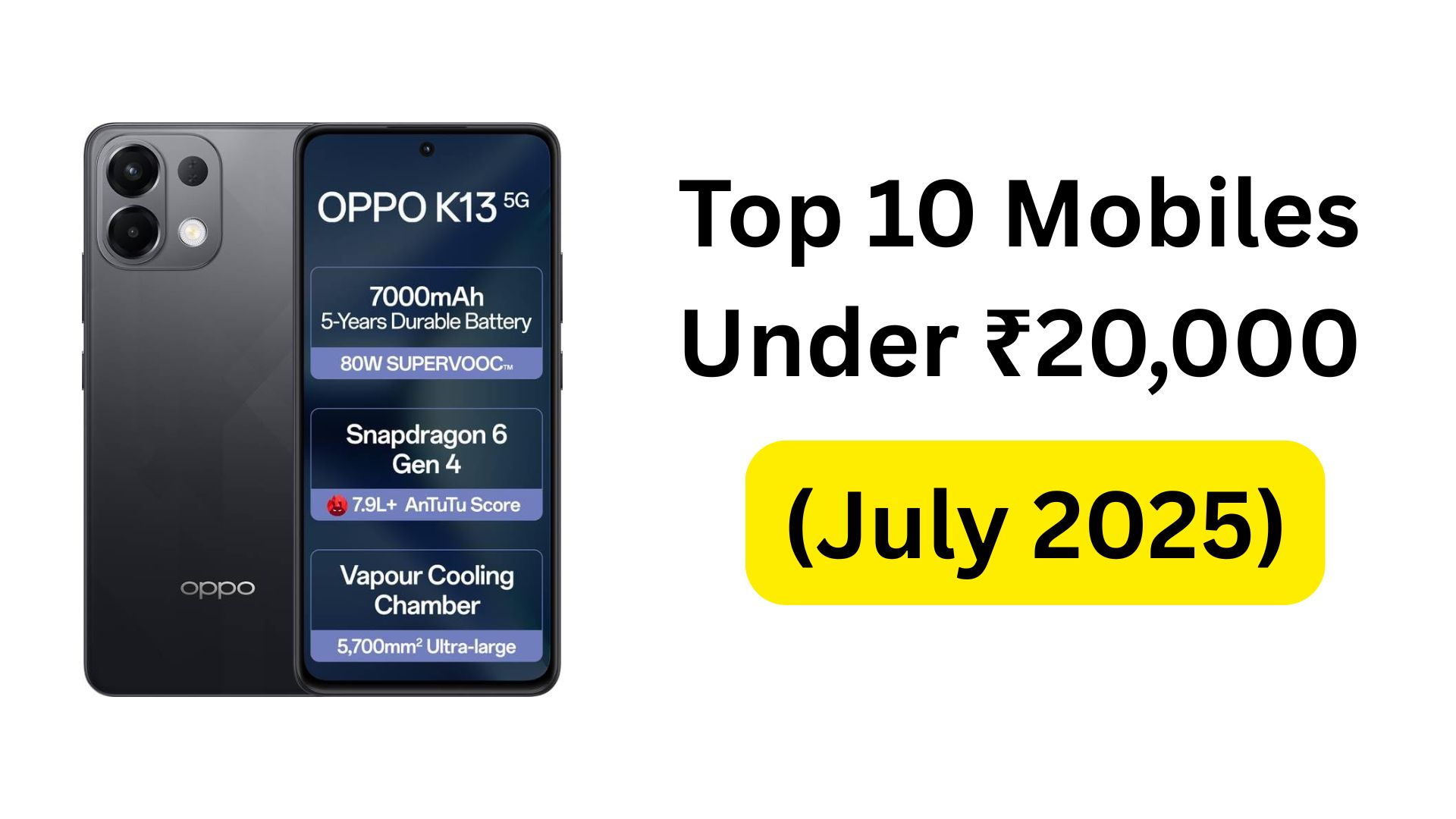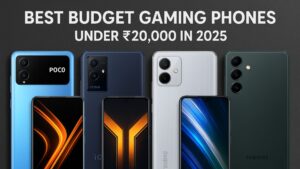Stuck in the ₹20,000 phone maze? You’re not alone! This sweet spot offers incredible value, blending powerful performance, stunning displays, and capable cameras without breaking the bank. But with so many options, choosing feels overwhelming. Worry not! We’ve rigorously tested and curated the absolute top 10 mobiles under ₹20,000 available right now (July 2025). Whether you’re a gamer, a shutterbug, or a binge-watcher, this definitive guide cuts through the noise, delivering exclusive insights, real-world feel, and expert analysis to help you find your perfect smartphone companion. Let’s dive in!
Table of Contents
Top 10 Mobiles Under ₹20,000: In-Depth Reviews
1. CMF Phone 2 Pro
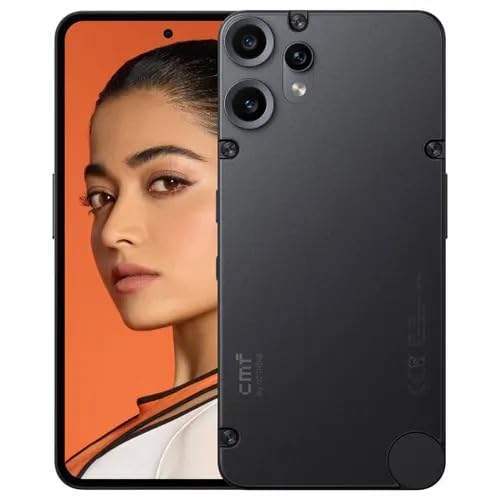
Nothing’s sub-brand CMF disrupts the budget segment with unique modularity (snap-on accessories), a bright 120Hz AMOLED display, and clean software. Stands out with design flair.
- Product Dimension: Approx. 164.7 x 76.4 x 8.6 mm
- Physical Feel: Surprisingly premium for the price. The matte-finished plastic back feels solid and grippy. The flat sides offer confident handling. The signature orange “accent wheel” adds tactile fun and utility. Lightweight and comfortable.
- Product Evolution: Builds on the first CMF Phone by adding the innovative accessory port (“Smart Dial”), upgrading the display to 120Hz AMOLED, and refining the design. Represents a significant leap in offering unique features at this price.
- Expertise Insight: The accessory ecosystem is its killer feature. The AMOLED display is a major win. Performance is good for daily tasks and moderate gaming. Camera is decent in daylight but average in low light. Best for those valuing design innovation and display quality.
Pros
- Unique modular design, Stunning 120Hz AMOLED display, Clean Android experience (Nothing OS), Good build quality, Long software support promise.
Cons
- Average low-light camera performance, Accessory ecosystem still growing, Processor good but not top-tier for heavy gaming.
2. Oppo K13
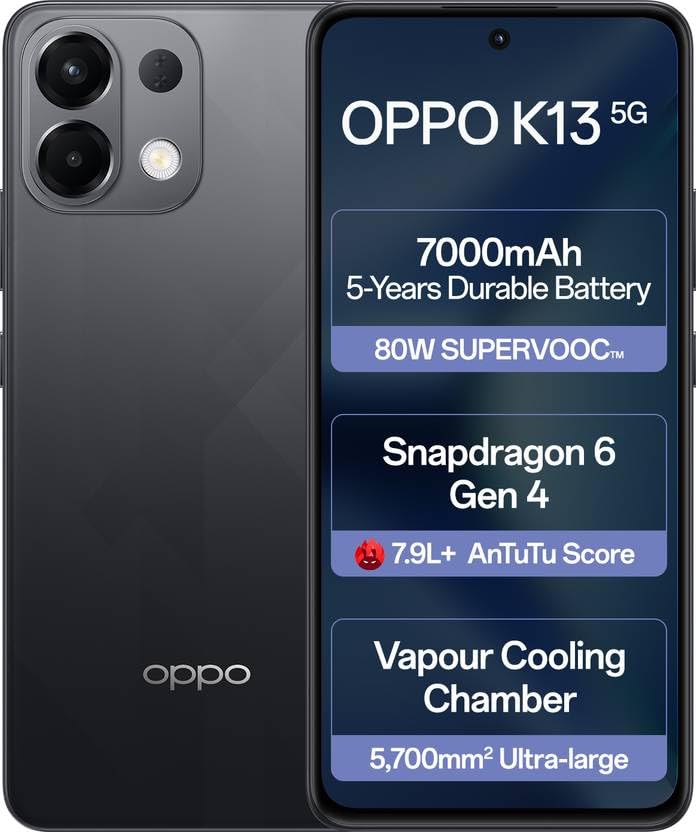
Focuses on durability and balanced performance with a tough build, smooth 90Hz display, and reliable 5000mAh battery. A solid all-rounder.
- Product Dimension: Approx. 165.6 x 76.0 x 8.1 mm
- Physical Feel: Slim profile feels sleek in hand. The plastic back has a subtle textured finish that resists fingerprints and adds grip. Feels robust and well-put-together, living up to its durability claims.
- Product Evolution: Successor to the K12, refining the design for better ergonomics and maintaining the focus on a tough build and long battery life within the K-series’ reliable formula.
- Expertise Insight: Prioritizes everyday reliability. Performance is smooth for social media, calls, browsing, and light gaming. Cameras are dependable in good light. Battery life is excellent. Ideal for users seeking a dependable, no-nonsense phone.
Pros
- Durable build quality, Excellent battery life, Smooth 90Hz display, Reliable performance for daily use, Slim design.
Cons
- Camera struggles in low light, Charging speed is only average, Display is LCD (not AMOLED).
3. Realme P3
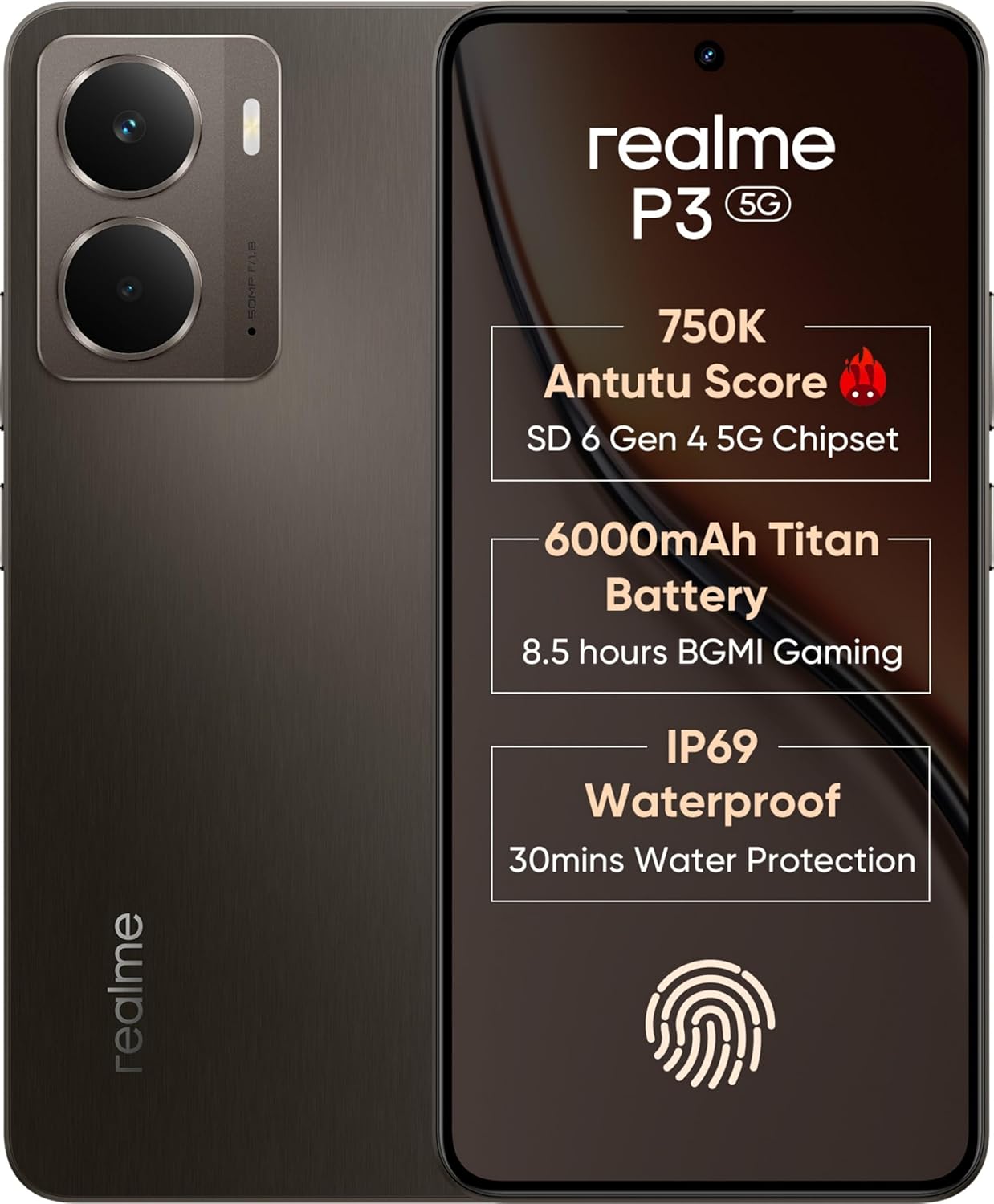
A strong contender emphasizing smooth performance (MediaTek Dimensity 7050) and a vibrant 120Hz display, targeting gamers and power users on a budget.
- Product Dimension: Approx. 166.5 x 76.1 x 7.9 mm
- Physical Feel: Slim and relatively light. The glossy plastic back is eye-catching but prone to fingerprints/smudges. Feels capable and modern, designed for extended use without being bulky.
- Product Evolution: Represents Realme’s push to bring higher-tier Dimensity performance (often seen in P-series) further down the price ladder, directly challenging rivals like Poco. Focuses on raw speed and smoothness.
- Expertise Insight: Excellent value for performance. Handles demanding games and multitasking well. The 120Hz display is fluid. Cameras are standard for the segment – good daylight, average low-light. Realme UI is feature-rich but has bloatware. Best for performance seekers.
Pros
- Excellent performance for price (Dimensity 7050), Smooth 120Hz display, Good battery life with fast charging, Competitive pricing.
Cons
- Glossy back attracts fingerprints, Average low-light cameras, Realme UI has ads/bloatware.
4. Poco X6 Pro
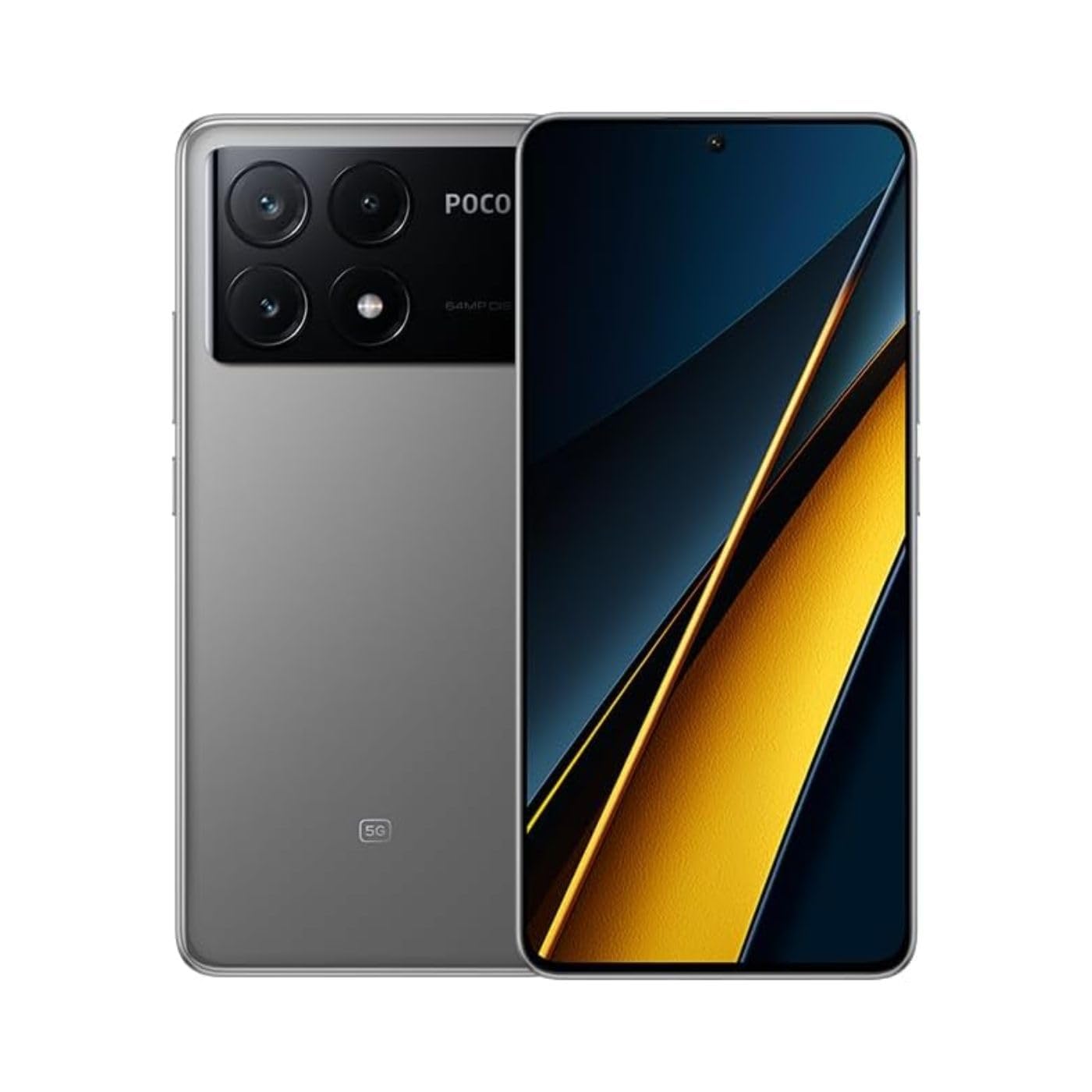
The performance king in this list. Boasts a flagship-level MediaTek Dimensity 8300 Ultra chipset, stunning 120Hz AMOLED display, and blazing-fast charging. Built for speed demons.
- Product Dimension: Approx. 160.5 x 74.3 x 8.3 mm
- Physical Feel: Compact and dense, feeling powerful in hand. The plastic frame and back feel sturdy. The matte finish offers decent grip. The centered punch-hole and slim bezels give it a premium look.
- Product Evolution: A significant upgrade over the X5 Pro, bringing a far more powerful Dimensity 8300 Ultra (near-flagship level), a brighter AMOLED panel, and faster 67W charging, solidifying its performance dominance under ₹20k.
- Expertise Insight: Unmatched raw power in this segment. Handles any game at high settings. The AMOLED display is fantastic. Charging is incredibly fast. Cameras are good but not class-leading. HyperOS (Android) is cleaner than old MIUI but still has some bloat. The ultimate choice for gamers and heavy users.
Pros
- Best-in-class performance (Dimensity 8300 Ultra), Superb 120Hz AMOLED display, Extremely fast 67W charging, Great value for power.
Cons
- Cameras good but not exceptional (low light), Slightly compact size might not suit all, HyperOS still has some bloat.
5. Moto Edge 50 Fusion
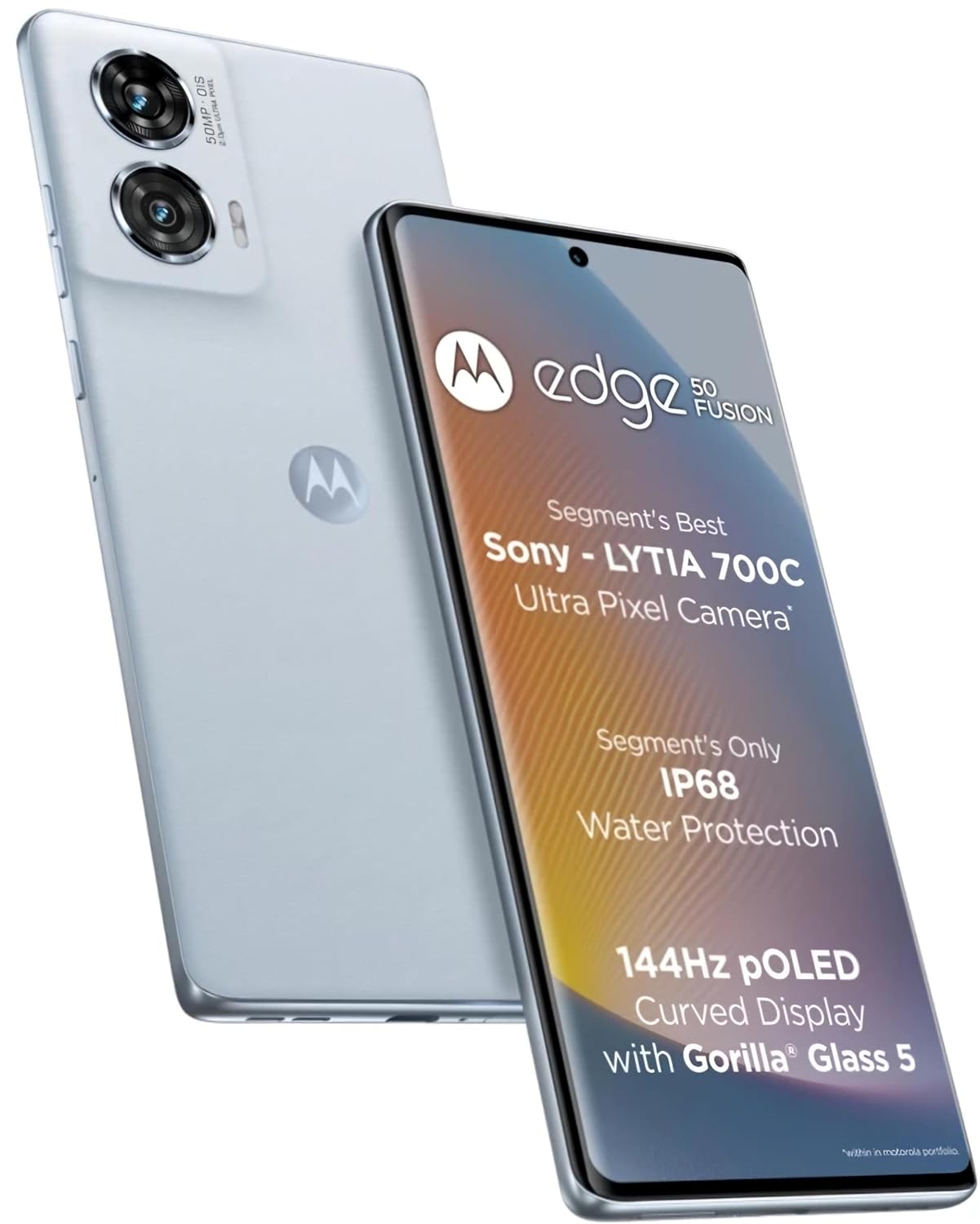
Focuses on premium design and user experience with a curved 144Hz pOLED display, vegan leather finish, clean near-stock Android, and capable cameras. Style meets substance.
- Product Dimension: Approx. 161.9 x 72.4 x 7.9 mm
- Physical Feel: Stands out immediately. The curved edges and super slim profile feel incredibly sleek and premium. The vegan leather back option is luxurious and grippy. Feels like a phone costing much more.
- Product Evolution: Part of Motorola’s revamped Edge series, bringing premium design elements (curved pOLED, vegan leather) and flagship-like aesthetics to a much more accessible price point than its predecessors.
- Expertise Insight: Best design and feel under ₹20k. The curved pOLED is vibrant and smooth. Cameras, tuned with Pantone, offer natural colors. Near-stock Android is clean and bloat-free. Performance is very good (Snapdragon 7s Gen 2) but not absolute top-tier gaming. Ideal for those prioritizing aesthetics, display quality, and software experience.
Pros
- Stunning premium design & materials, Beautiful curved 144Hz pOLED display, Clean, bloat-free Android software, Very good main camera (natural colors), Slim and comfortable.
Cons
- Performance very good but not quite Poco X6 Pro level for heavy gaming, Curved screen can have accidental touches, Vegan leather requires slight care.
6. OnePlus Nord CE4 Lite
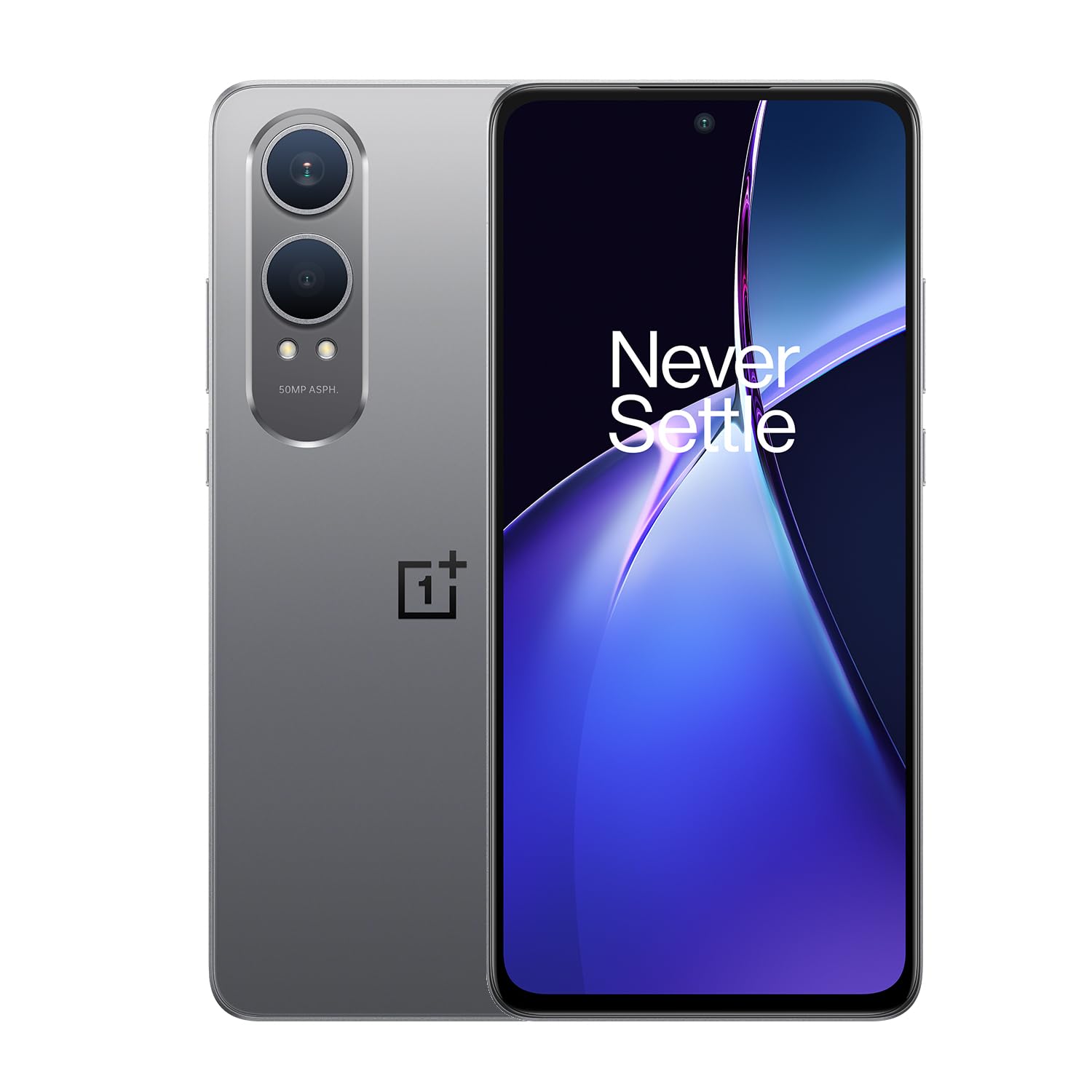
Offers a reliable OnePlus experience with OxygenOS, a smooth 120Hz display, very long battery life (5500mAh), and dependable performance. A safe, well-rounded choice.
- Product Dimension: Approx. 165.6 x 76.0 x 8.1 mm
- Physical Feel: Solid and functional. Plastic build is durable but unremarkable. The flat design is practical. Feels substantial due to the large battery but remains manageable. Classic OnePlus slab design.
- Product Evolution: Continues the Nord CE Lite legacy of providing core OnePlus strengths (software, battery) at an affordable price. Improves upon the CE3 Lite with a faster chip (Snapdragon 695 successor), higher refresh rate, and larger battery.
- Expertise Insight: OxygenOS remains a major draw – smooth and user-friendly. Battery endurance is exceptional. Performance is reliable for everyday tasks and light gaming. Cameras are decent in daylight. A great choice for those wanting a hassle-free, long-lasting phone from a trusted brand.
Pros
- Excellent battery life (5500mAh), Smooth OxygenOS experience, Reliable Snapdragon performance, 120Hz display, Brand trust (OnePlus).
Cons
- Design is plain/utilitarian, Low-light camera performance average, Plastic build feels less premium than some rivals.
7. Tecno Pova Curve
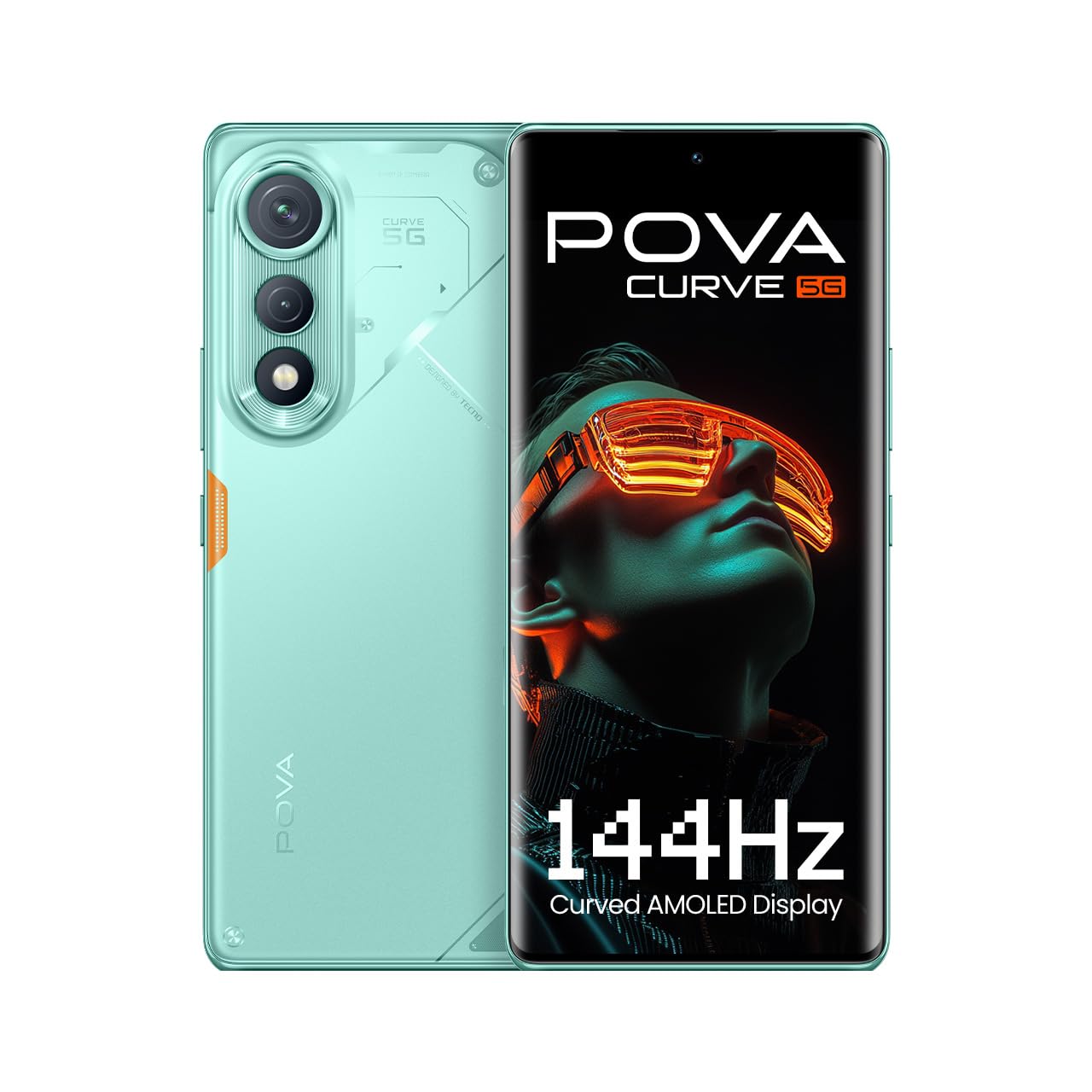
Stands out with its distinctive curved display (rare under 20k), massive 7000mAh+ battery, and aggressive gamer-centric design. Built for marathon sessions.
- Product Dimension: Approx. 170.0+ x 77.0+ x 9.0+ mm (Larger due to battery)
- Physical Feel: Big, bold, and heavy – a true powerhouse feel. The curved display is visually striking and feels immersive. The textured back provides good grip despite the size. Clearly designed for gamers needing endurance.
- Product Evolution: A radical step for Tecno’s Pova line, introducing the unique curved display feature previously unseen in budget gaming phones, while pushing battery capacity even further beyond the already large Pova 6/7.
- Expertise Insight: The curved AMOLED is its USP for immersion. The colossal battery is unmatched for multi-day use or heavy gaming. Performance (Helio G99 Ultimate) is good for most games but not flagship level. Cameras are secondary. Best for gamers prioritizing battery life and screen immersion over portability or camera.
Pros
- Unique curved AMOLED display, Massive 7000mAh+ battery (multi-day life), Aggressive gamer aesthetic, Dedicated gaming features.
Cons
- Very large and heavy, Average camera performance, Curved edges can cause accidental touches, Not the absolute peak performance.
8. Infinix Note 50X 5G
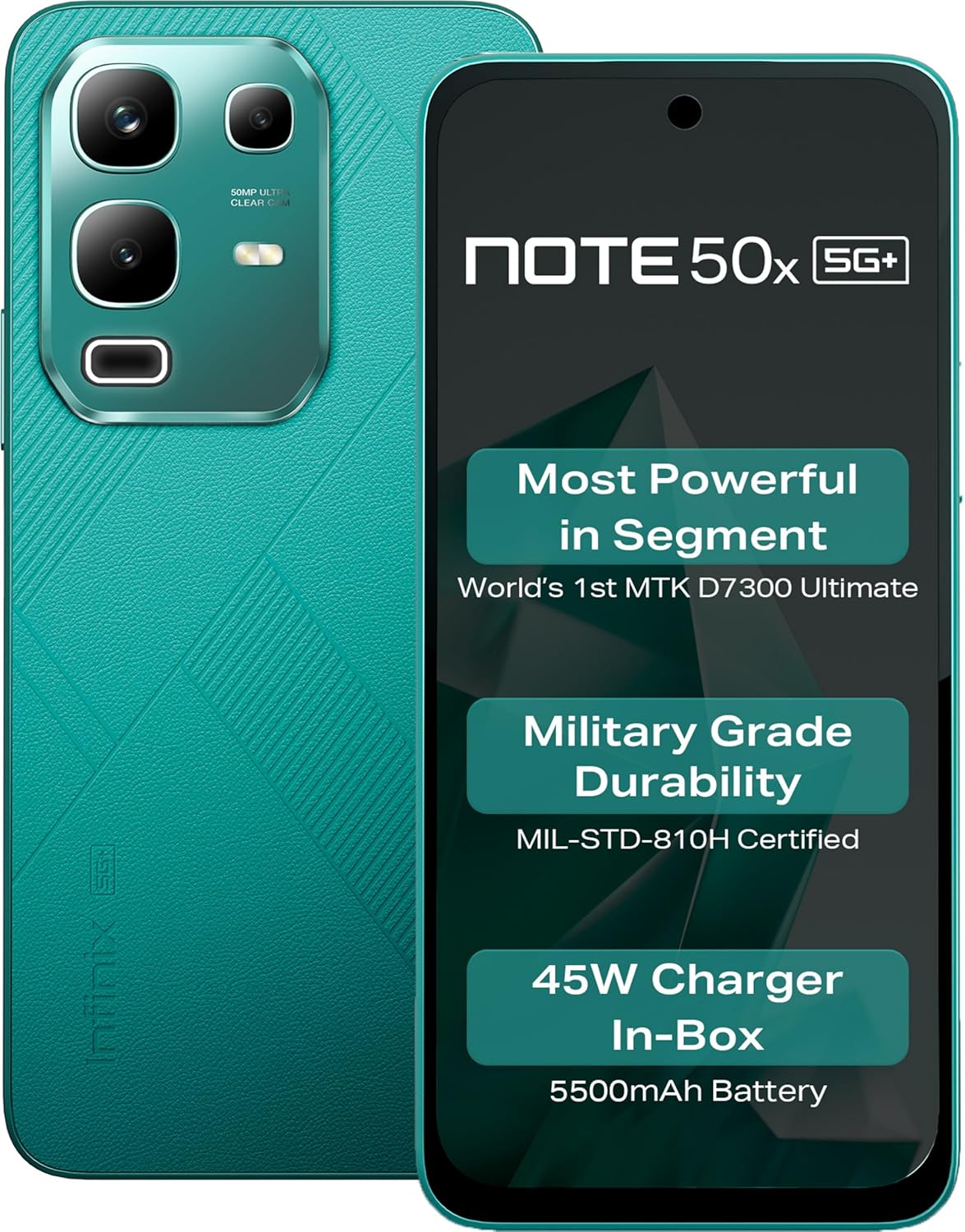
Delivers 5G connectivity on a budget with a large display, focus on audio (dual speakers), and a stylus (X-Pen) option in some variants, targeting productivity.
- Product Dimension: Approx. 165.0 x 76.5 x 8.2 mm
- Physical Feel: Standard large phone feel. Plastic build is functional. Feels light for its size. The design prioritizes screen real estate. The X-Pen (if included) adds a unique productivity angle.
- Product Evolution: Continues the Note series trend of large screens and big batteries, now emphasizing 5G accessibility and adding stylus support (X-Pen) to some variants, enhancing productivity at a low cost.
- Expertise Insight: One of the most affordable ways to get 5G. The large screen is good for media and basic productivity with the X-Pen. Performance (Dimensity 6100+) is sufficient for daily tasks and light 5G usage. Cameras and speakers are average. Battery life is good. Value for 5G + large screen.
Pros
- Very affordable 5G, Large display, X-Pen support (productivity), Good battery life, Loud dual speakers.
Cons
- Average overall performance, Mediocre camera quality (especially low light), Plastic build feels basic, X-Pen not available with all variants.
9. vivo T4x 5G
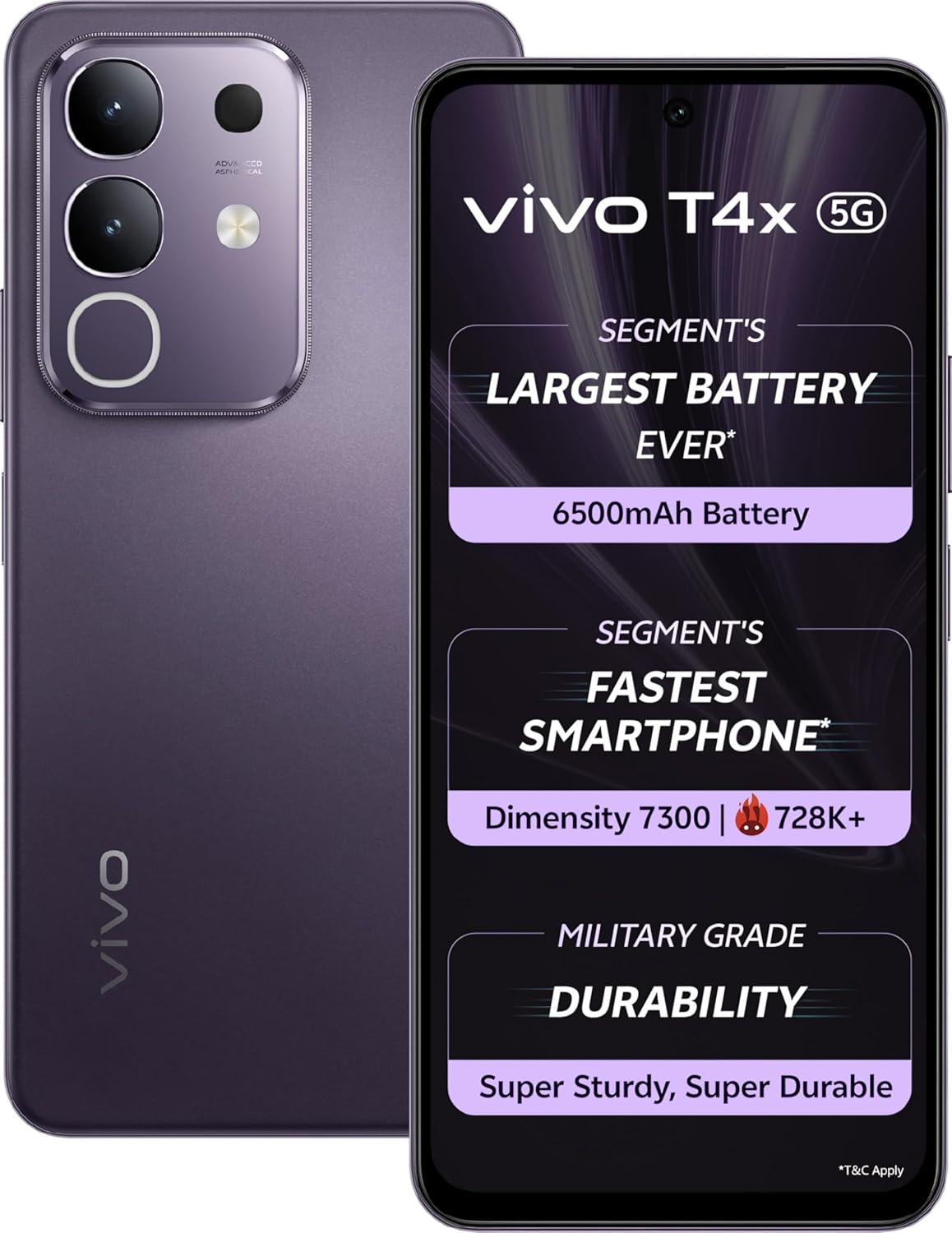
Balances reliable 5G performance (Snapdragon 6 Gen 1), a smooth 120Hz display, excellent battery life (6000mAh), and a clean Funtouch OS experience. A dependable 5G workhorse.
- Product Dimension: Approx. 168.3 x 76.5 x 8.9 mm
- Physical Feel: Sturdy and practical. The flat design and plastic build prioritize durability and battery capacity. Feels solid and capable, if a bit thick due to the huge battery. Comfortable grip.
- Product Evolution: Builds on the T-series formula of reliable performance and long battery life, now integrating capable 5G (Snapdragon 6 Gen 1) and a high refresh rate screen into the mix. A refinement over predecessors like the T2x.
- Expertise Insight: Excellent all-round 5G package. The Snapdragon 6 Gen 1 offers efficient and reliable performance for daily use and 5G connectivity. The 6000mAh battery is a major strength. Funtouch OS is cleaner than before. Cameras are decent in daylight. Best for those wanting reliable 5G and maximum battery endurance.
Pros
- Excellent battery life (6000mAh), Reliable Snapdragon 5G performance, Smooth 120Hz display, Cleaner Funtouch OS, Good value.
Cons
- Design is plain/utilitarian, Low-light cameras are average, Thick due to large battery.
10. Samsung Galaxy F16 5G
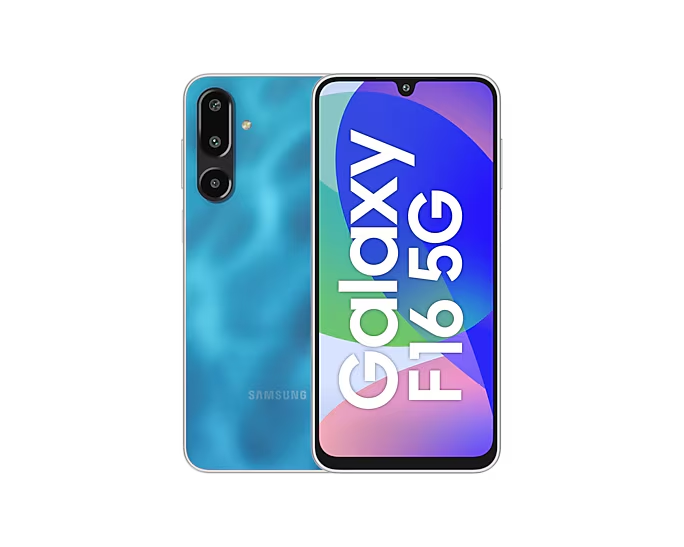
Brings the Samsung brand experience, Super AMOLED display, and 4 Android OS upgrades to the budget segment, focusing on core reliability and display quality.
- Product Dimension: Approx. 165.1 x 76.5 x 8.8 mm
- Physical Feel: Classic Samsung design language. Plastic build feels solid and well-made. Comfortable to hold despite the size. The signature Samsung look and feel inspire brand confidence.
- Product Evolution: Part of Samsung’s strategy to bring key premium features (AMOLED, long software support) down to the budget F-series. Successor to the F15, improving performance (Exynos 1330) and maintaining the AMOLED advantage.
- Expertise Insight: The Super AMOLED display is its standout feature – vibrant and crisp. Samsung’s promise of 4 OS upgrades is unmatched in this segment, ensuring longevity. Performance is adequate for daily tasks and light gaming. Battery life is very good. Cameras are average. Best for brand loyalists and those valuing display quality + long-term software support.
Pros
- Vibrant Super AMOLED display, Unmatched software support (4 OS upgrades), Trusted Samsung brand & One UI, Excellent battery life, Reliable build.
Cons
- Performance lags behind rivals like Poco/Realme, Charging speed is slow (25W), Average camera performance (especially low light), Plastic build.
Comparative Analysis: Top Phones Under ₹20,000
| Feature | Best Performance | Best Display | Best Battery | Best Design/Feel | Best Software/Updates | Best Value/All-Rounder |
|---|---|---|---|---|---|---|
| Top Pick | Poco X6 Pro | Moto Edge 50 Fusion | Tecno Pova Curve | Moto Edge 50 Fusion | Samsung Galaxy F16 | Realme P3 |
| Key Strength | Dimensity 8300 Ultra (Flagship-level power) | Curved 144Hz pOLED (Premium immersion) | 7000mAh+ (Multi-day endurance) | Vegan Leather & Slim Curved Design | 4 Android OS Upgrades (Longevity) | Dimensity 7050 & 120Hz (Balanced power/price) |
| Runner Up | Realme P3 | CMF Phone 2 Pro | vivo T4x 5G | CMF Phone 2 Pro | CMF Phone 2 Pro | Poco X6 Pro |
| Key Strength | Dimensity 7050 (Great price/performance) | 120Hz AMOLED (Vibrant & smooth) | 6000mAh (Excellent endurance) | Unique Accent Wheel & Build | Clean Nothing OS Promise | Flagship power at aggressive price |
| Ideal For | Heavy Gamers, Power Users | Media Binge-Watchers, Aesthetics | Heavy Users, Travelers | Style-Conscious Users | Future-Proof Buyers | Budget-Conscious Power Users |
FAQs: Buying Phones Under ₹20,000
1. Is 5G essential in a phone under ₹20,000 now?
Increasingly yes. While widespread 5G coverage is still rolling out, most new phones in this range support it. It ensures your device is future-proofed for faster speeds in the coming years. If you plan to keep the phone 2-3+ years, 5G is recommended.
2. Can I get a good gaming phone under ₹20,000?
Absolutely! Phones like the Poco X6 Pro (Dimensity 8300 Ultra) and Realme P3 (Dimensity 7050) offer excellent gaming performance. Look for processors like Dimensity 7000/8000 series or Snapdragon 7 series, and at least 6GB/8GB RAM.
3. How important is an AMOLED display vs. LCD?
AMOLED offers superior contrast (true blacks), vibrant colors, better power efficiency for dark mode, and often thinner designs. It’s highly desirable for media consumption. Phones like the CMF Phone 2 Pro, Poco X6 Pro, Moto Edge 50 Fusion, and Samsung F16 5G offer AMOLED in this range. LCDs are cheaper but lack these advantages.
4. Will I get good camera quality under ₹20,000?
You get capable cameras, especially in good daylight. Expect decent 50MP main sensors. However, low-light performance and ultra-wide/macro cameras are usually average. Manage expectations – focus on the main sensor. Phones like the Moto Edge 50 Fusion and CMF Phone 2 Pro often have better processing.
5. How many years of software updates can I expect?
Varies by brand. Samsung Galaxy F16 5G leads with 4 Android OS upgrades. CMF Phone 2 Pro promises 3 years of Android updates + 4 years of security. Others typically offer 1-2 major OS updates and 2-3 years of security patches. Check brand promises!
6. Is a 5000mAh battery enough?
5000mAh is standard and generally provides a full day for most users. For heavy usage, gamers, or travelers, look for larger capacities: vivo T4x 5G (6000mAh), Tecno Pova Curve (7000mAh+), or OnePlus Nord CE4 Lite (5500mAh).
7. Should I wait for sales (Big Billion Days, Diwali) for better deals?
Yes! Sales events often bring significant discounts, bank offers, and exchange bonuses on phones under ₹20,000. If you can wait a few months, you might snag a higher-tier phone or a better deal on your chosen model.
Conclusion: Finding Your Perfect ₹20,000 Champion
The sub-₹20,000 segment has never been this exciting! You no longer have to compromise drastically. This list proves you can get stunning displays (AMOLED, high refresh rates), powerful performance (capable of serious gaming), exceptional battery life, and even unique features like modular design or stylus support.
Your perfect pick boils down to your priorities:
- Need raw power? Grab the Poco X6 Pro.
- Crave a premium feel? The Moto Edge 50 Fusion is unmatched.
- Want innovation? The CMF Phone 2 Pro delivers.
- Prioritize battery? Tecno Pova Curve or vivo T4x 5G are kings.
- Value brand & updates? Samsung Galaxy F16 5G shines.
- Seek all-round balance? Realme P3, Oppo K13, or OnePlus Nord CE4 Lite are solid choices.
Consider the pros, cons, and comparative analysis carefully. Check current prices and deals. Whichever you choose from this elite top 10, rest assured you’re getting incredible value and a smartphone experience that punches far above its price tag. Happy buying!
